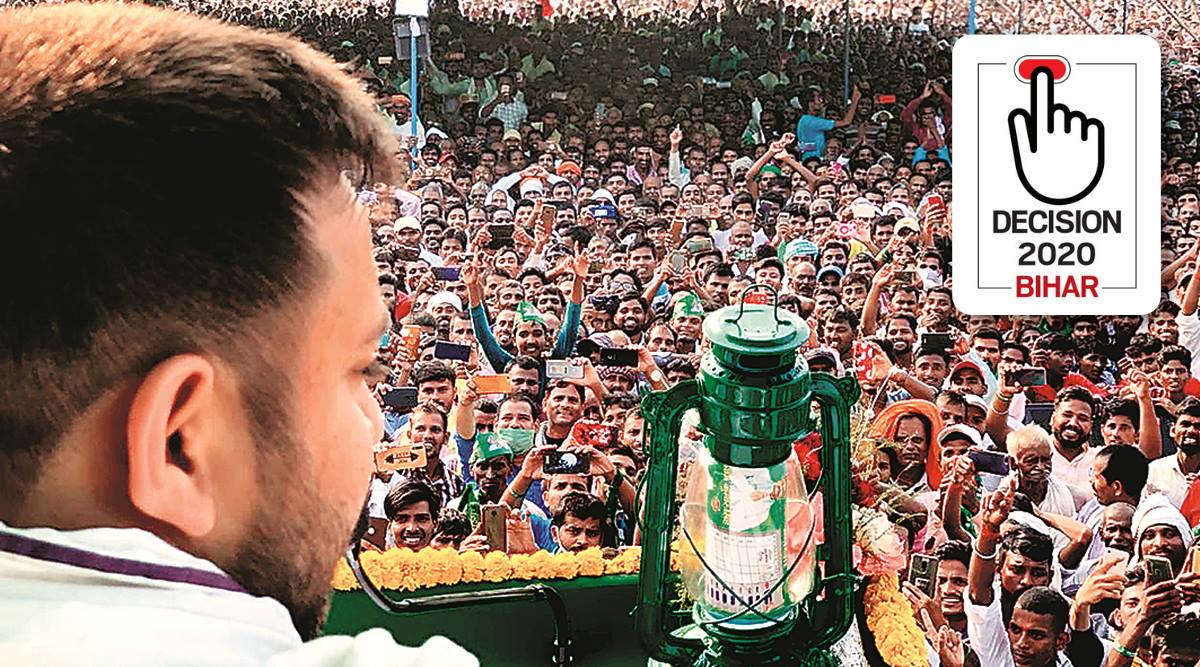 In a sign that Tejashwi’s rallies are having an effect on the rival JDU camp, party working president Ashok Choudhary recently posted photographs of a rally Nitish Kumar held in Bhore in Gopalganj, where a sizeable crowd had turned up.
In a sign that Tejashwi’s rallies are having an effect on the rival JDU camp, party working president Ashok Choudhary recently posted photographs of a rally Nitish Kumar held in Bhore in Gopalganj, where a sizeable crowd had turned up.Across rallies, the images are much the same. Crowds packed in, with very few masks and no social distancing. But right from when RJD leader Tejashwi Yadav’s helicopter begins to descend, they begin cheering wildly, and then follow him in a wave as he walks to the stage, and speaks.
With the first phase of polling for the Bihar Assembly elections a week away, the crowds that are turning up to hear Tejashwi, the Mahagathbandhan’s chief ministerial candidate, at his rallies are becoming a talking point. While the RJD is reading this as a sign that people in the state are ready for change, the ruling JD(U) is at pains to explain that the turnout at rallies are no measure of vote transferability.
What seems to be enthusing the crowd most is Yadav’s promise — one that he makes in each of his speeches — of 10 lakh government jobs in his first act as chief minister. In his last rally of the day in Paliganj on Tuesday, Yadav told the crowd to loud cheers: “Ek mauka milega, toh jis din peh mantrimandal ki baithak hogi, pehli baar mukhyamantri hote hue pen chalegi, toh desh ke itihaas mein pehli baar ek saath 10 lakh naujavaan ko ikatthe sarkaari naukri milega.” Loosely translated, it means that if given a chance, he will sign on his promise of 10 lakh government jobs on his first day in office.
Given Bihar’s long history of caste and social justice politics, those gauging the Opposition’s chances have largely stuck to seeing whether the RJD can expand beyond its core voter base of Yadavs and Muslims.
RJD leaders, however, believe that the rallies are proof that this conventional wisdom may not hold true for 2020, a year of deep economic distress.
RJD Rajya Sabha MP Manoj Jha told The Indian Express, “There is a rigid arithmetic some people in Delhi follow. But that rigidity of caste arithmetic is breaking. Whether it is breaking 35 per cent or 30 per cent, I can’t tell you… What I can say for sure is that it is breaking.”
In a sign that Tejashwi’s rallies are having an effect on the rival JDU camp, party working president Ashok Choudhary recently posted photographs of a rally Nitish Kumar held in Bhore in Gopalganj, where a sizeable crowd had turned up.
“There was a jansabha of Chief Minister Nitish Kumar in Bhore. Opponents should not be scared while looking at the crowd. Please see, so-called youth leader Tejashwi Yadav of the RJD and Tej Pratap Singh, the sons of Lalu Prasad. This is the love and respect Nitish Kumar gets,” he tweeted.
And yet, the pictures tell the story. While Yadav’s rallies are chaotic, with the crowds almost surging on to the packed stage, the CM’s are more orderly. In the Gopalganj rally, as in many others, the crowds were at least 20 metres away from the stage, and while masks and social distancing were in short supply here, too, most participants were seated on chairs under a shamiana.
Jha said the spontaneity at Yadav’s rallies was because he had become the “face of Bihar versus Nitish Kumar”. “People are able to connect to the issues raised by Tejashwi ji. We have seen huge crowds before, but what is interesting is that this is an interactive, active crowd. This crowd has not come to listen to the leader, this crowd has come to engage with the leader,” he said.
Senior JDU spokesperson Arvind Nishad, however, dismissed the numbers at Tejashwi’s rallies.
“If you look at the trend of rallies, whether it was Lalu ji earlier, or now of Tejashwi ji’s, the media can analyse them as they want. But those who come to Nitish Kumar’s rallies are the chuppa (silent) voters. He only knows how to come and show his support by voting. So to analyse elections or popular support through rallies is not correct. Those who come to rallies may come on their own, but it needs to be seen if this transfers to votes. In the last 20 years, the vote has always been one of faith with Nitish Kumar.”
📣 The Indian Express is now on Telegram. Click here to join our channel (@indianexpress) and stay updated with the latest headlines
For all the latest Elections News, download Indian Express App.